“We wanted the bike to look like it was going 100mph standing still.”
In 1989, Honda unveiled a modern reincarnation of the greatest lightweight fours ever produced, the CB400F. The new Honda 400/4, known as the CB-1 — aka the NC27 or CB400F — boasted a liquid-cooled four-valve engine, beefy perimeter frame, Pro-Link rear shock, and three-spoke mag wheels:
“Putting out almost 55hp and a redline of 13,500rpm made for one screaming demon.” –Evan Gregory, Protoworks Manufacturing
The CB-1 eschewed the modern full-fairing trend in favor of the naked styling of the original, and surprisingly enough, this exotic liquid-cooled four was available in the US and Canada! Cycle World was simply in love with the new machine:
“A reincarnation of the standard motorcycle…the sort of bike everyone rode before sporting riders went replica racer crazy.”
Unfortunately, the bike was short-lived, axed after 1990 due to poor sales. But that’s where enthusiasts like father/son duo Bill and Evan Gregory of Ontario’s ProtoWorks Manufacturing Inc step in. Says Evan:
“It’s a shame it didn’t stick around longer, but at least there are those of us who are willing to keep the flames of the CB1 burning hot. With vigorous enthusiasm we are determined to keep as many of them as possible on the road.”
Evan and his father are both certified machinists with a vast repertoire of skills in their arsenal: CNC, CAD, 3D printing, metal fabrication, engine building/tuning, and more. Father Bill built a ’79 Suzuki GS750 in the early 80s and went superbike racing:
“Although only modest success was earned on the track, valuable technical knowledge was gained regarding motorcycle performance and design modifications.”
Now the father/son team are determined to make their living in the custom motorcycle market, building restomods as a platform for developing and marketing a range of high-grade components through their new company, ProtoWorks Manufacturing Inc:
“Our objective is to take particular models that represent milestones in the industry or bikes that have become somewhat iconic and transform them into machines that represent current technology and styling tastes, while maintaining recognizable aspects of their original lines.”
The CB-1 you see here is a 1990 model that has undergone a massive transformation, including a bespoke swingarm, Kawasaki ZX6R rear wheel and front end, Kawasaki Ninja 300 tail, LCD instrument display, relocated electrics, custom silencer, and a vast array of 3D-printed or hand-fabricated parts to graft the various pieces into a final product that looks like it was factory-built by Honda’s own R&D team.
The level of execution and detail is stunning, and the CB400F decals are a particularly nice touch — not only do they hark back to the bike’s predecessor, but the CB-1 was marketed as the CB400F in certain markets. Overall, this is one of those bikes that we want to ride as much as ogle — which is part of Evan and Bill’s driving philosophy:
“We don’t build bikes for show. Each has a practical function and is intended to be ridden…Each bike is built for performance and styling, intended to be exploited on the road.”
Below, we get the full details on this sleek 400cc restomod — can’t wait to see the CBX they have in the works!
Honda NC27 Restomod: In the Builder’s Words
Also known as CB400F or NC27, the Honda CB1 was only available in North America for two years, 1989 and 1990. Considering its extremely short existence in our showrooms here, it has a fairly significant following. Many people we meet fondly remember this motorcycle for its overall performance and nimble handling. The presence of a 400cc, 4-cylinder, liquid cooled motorcycle is a rare treat for us in North America. Such a motorcycle is usually destined for markets elsewhere in the world. Putting out almost 55hp and a redline of 13,500rpm made for one screaming demon. It’s a shame it didn’t stick around longer, but at least there are those of us who are willing to keep the flames of the CB1 burning hot. With vigorous enthusiasm we are determined to keep as many of them as possible on the road.
This is where me and my dad step in. We are garage builders with the goal of making a living in the custom motorcycle market. Our plans are not to build custom motorcycles for the sake of it. Our goal is to develop a range of products, using the bikes we build as a platform for developing and marketing these products.
Our skills range from conventional & CNC machining, metal fabrication, 3D plastic printing, painting & finishing, engine building & tuning, CAD design and mechanical engineering. We are both certified machinists. My dad has a background in superbike racing from the early ’80’s, when it was still somewhat in its infancy. Among other bikes, he hand-built a 1979 Suzuki GS750 race bike at the machine shop where he worked and went superbike racing. Although only modest success was earned on the track, valuable technical knowledge was gained regarding motorcycle performance and design modifications.
With our joint involvement, our objective is to take particular models that represent milestones in the industry or bikes that have become somewhat iconic and transform them into machines that represent current technology and styling tastes, while maintaining recognizable aspects of their original lines. We don’t build bikes for show. Each has a practical function and is intended to be ridden. Hence, they will not be adorned with a lot of chrome or unnecessary finishing touches. Each bike is built for performance and styling, intended to be exploited on the road.
Our first build was a 1983 Suzuki GS1100E, known for its superior handling in its time and an engine that is synonymous with the term bulletproof. This bike is a monster, which we will elaborate in a separate submission. Our next build was the CB1 we are presenting to you today. Our next build is a 1981 Honda CBX. Currently in process, our intent is to return this bike to the form which it was originally created by foregoing the fairing and saddlebags. Completion date will be mid 2021.
Back to the CB1, we completed this project in mid 2019 and entered it into the builders competition at the 2020 Motorcycle Supershow in Toronto, where it earned a top 10 finish in the cafe racer category. We wished there was a restomod category to compete in, as this bike is definitely not a cafe racer. Nevertheless, we were very pleased with the attention this bike attracted, as it was the first time we competed in a builder competition. It helped validate our efforts and gave us great pride knowing what we are doing was being recognized by our peers.
Particular aspects of this build centered specifically around the suspension and chassis. The motor remained stock, at least for now. The only original parts that exist on this build are the motor, gas tank and a portion of the frame. Everything else was procured from other motorcycles or designed & built by us.
The four most significant changes we made were the suspension, swingarm, frame and bodywork. We wanted to produce a bike which enhanced the handling by incorporating modern wheels, brakes and suspension. We wanted to reduce the weight by removing all unnecessary items and/or replace them with trimmer and more aesthetically pleasing components. We also wanted to clean up the lines of the bike and give it a leaner look. Creating a large gap between the rear wheel & seat or the motor & exhaust pipes creates what we feel is a stealthy look. We wanted the bike to look like it was going 100mph standing still. In our opinion, we believe we achieved that and more.
A considerable amount of time was spent working out how we wanted the bike to look, then we set out to find the components that would satisfy that requirement. We purchased the complete front end and rear wheel from a 2009 Kawasaki ZX6R. Although it’s not necessary on such a light motorcycle, the bike now has a massive 180mm Pirelli Rosso tire on the back and proportionally sized tire on the front. This gives the bike a very solid looking stance as well as the ability to stick like glue in the corners.
We purchased a near complete rear seat assembly from a 2016 Kawasaki Ninja 300. Pieces not available to finish the tail assembly were designed and 3D printed by us. We had to bridge the gap between the tail bodywork from the Ninja 300 and gas tank on the CBI. We spent many hours working out the design in Fusion 360 before settling on the end result you see on the bike today. The only thing we would do differently is use an alternative grade of plastic to avoid the distortion we are experiencing on the existing side covers. Additionally, we had to fill the gap between the tail assembly and seat rails we fabricated. These pieces were also designed and 3D printed by us.
Our 3D plastic printer is not the largest nor the fastest, but we can produce some wonderful work with it and apply this technology to wide array of applications, such as instrument housings, velocity stacks, side cover tabs, to name a few.
The creation of the seat frame presented two unique challenges. We had to reverse engineer the tail assembly from the Ninja 300 to establish the design of the seat frame to accommodate the mounting points on all the plastic parts and seat bases. We also needed to figure out where to place all the electrical components. In Honda’s wisdom, they placed a majority of these components in the tail assembly. In our effort to create the lean stealthy look we were to achieve, we needed to find a new location for all these items. We found that place under the gas tank.
We did away with the stock airbox and ducting by replacing these items with individual K&N air filter pods. This created the room we needed to place all the electrical components under the tank. We also replaced the stock battery with an Anti Gravity brand and found a home for it under the tank also. The only component that remains in the tail is the voltage regulator. Considering it needs to remain cool, we felt that was the most appropriate place for it.
In addition to relocating the electrical components, we replaced the plastic coolant reservoir with an aluminum one we fabricated, brush finished and fitted under the radiator. This enabled us to tidy up the area around the rear shock, which is now is very prominent. With the spring painted bright yellow it only adds to that prominence.
We replaced the swingarm with one we designed and fabricated to accommodate the wider wheel from the ZX6R. The wheelbase was also increased by 1.00″ purely for aesthetic reasons. This increased the gap between the the rear wheel and frame, enhancing the light stealthy look. The shock lug on the swingarm was also made less chunky to help achieve the same goal.
The stock foot pegs were modified to eliminate the solid heel plates. The stock plate on the brake side provided a mount for the rear master cylinder. With the heel plate gone, we fabricated and grafted a mounting bracket for the master cylinder onto the stock footpeg bracket. The heel plates were replaced with lighter versions we fabricated from thinner aluminum sheet, then drilled an array of holes into them for further lightness.
The stock instruments were replaced with an LCD display. We designed and 3D printed a housing for it so we could integrate it with the top triple clamp. The headlight & turn signal bracket was replaced with pair of smaller brackets that clamp onto the fork tubes. We installed smaller and much more discrete LED turn signal lights front and back.
Once all the fabrication and integration work was done, we needed to establish what colour scheme the bike was to adorn. Our personal philosophy is to incorporate no more than four dominant colours. There may be small additions of other colours, but must be relegated to modestly sized components, fasteners and similar items.
The four dominant colours on this bike are grey, red, black and aluminum.The tank and tail was painted Audi nardo grey. The frame was painted bright red. Custom-made Honda CB400F stickers for the tank and tail were made to compliment the colour scheme. The engine was painted matte black along with the decorative aluminum plates on each side of the head set. Exposed edges of these plates were brushed to expose the aluminum underneath.
The only work we did that was related to the motor was rejet the carbs to adjust for the air pods and muffler. We kept the original 4 into 1 collector and fabricated our own muffler. The outer tube is stainless steel.
The stock idle jets were modified to accept a threaded insert which has the orifice drilled into it. We had to utlize all our skills in micro machining to pull this off. These inserts eliminated the need the replace the entire idle jet, which can get rather expensive given they are a fairly rare item.
We enjoyed working on this project and were pleasantly surprised by the attention it has garnered. Like the GS1100, what has been learned will be used to improve how we apply ourselves on future builds.

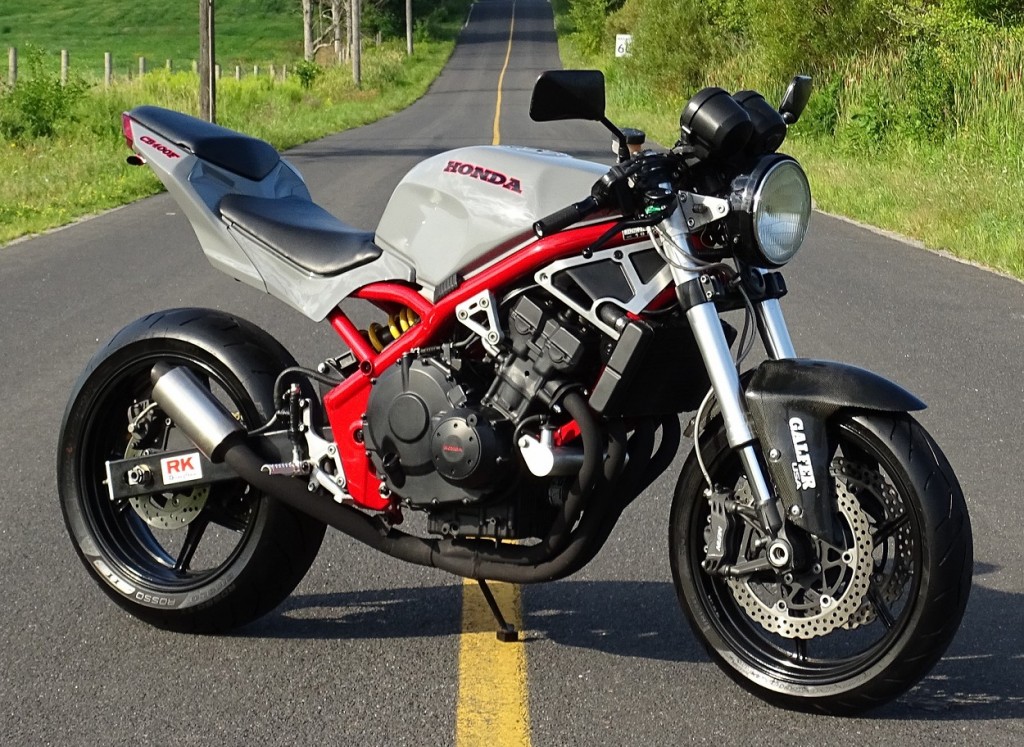
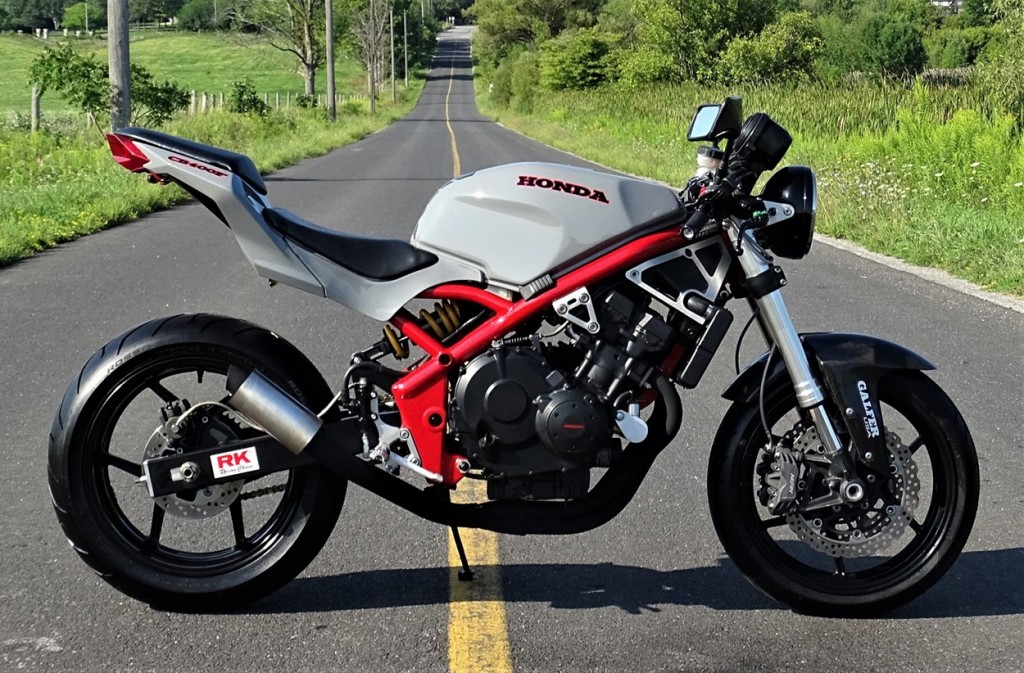
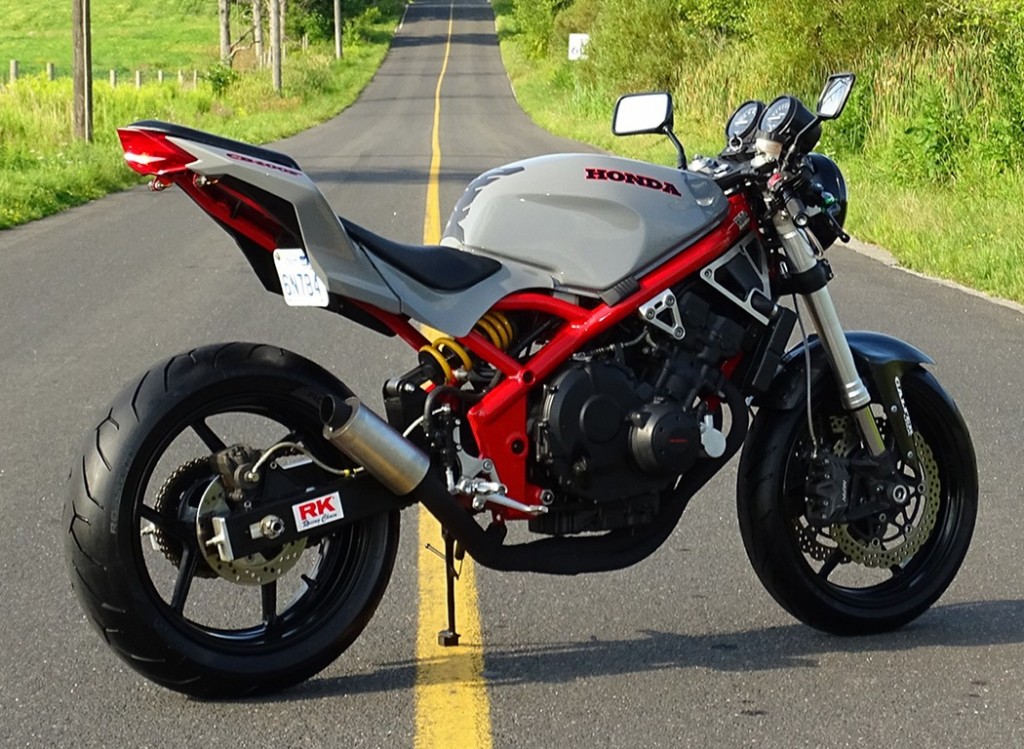

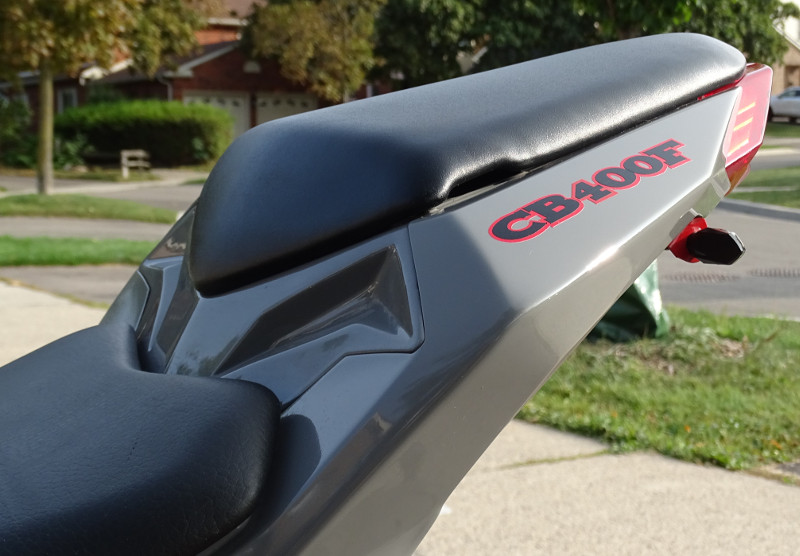




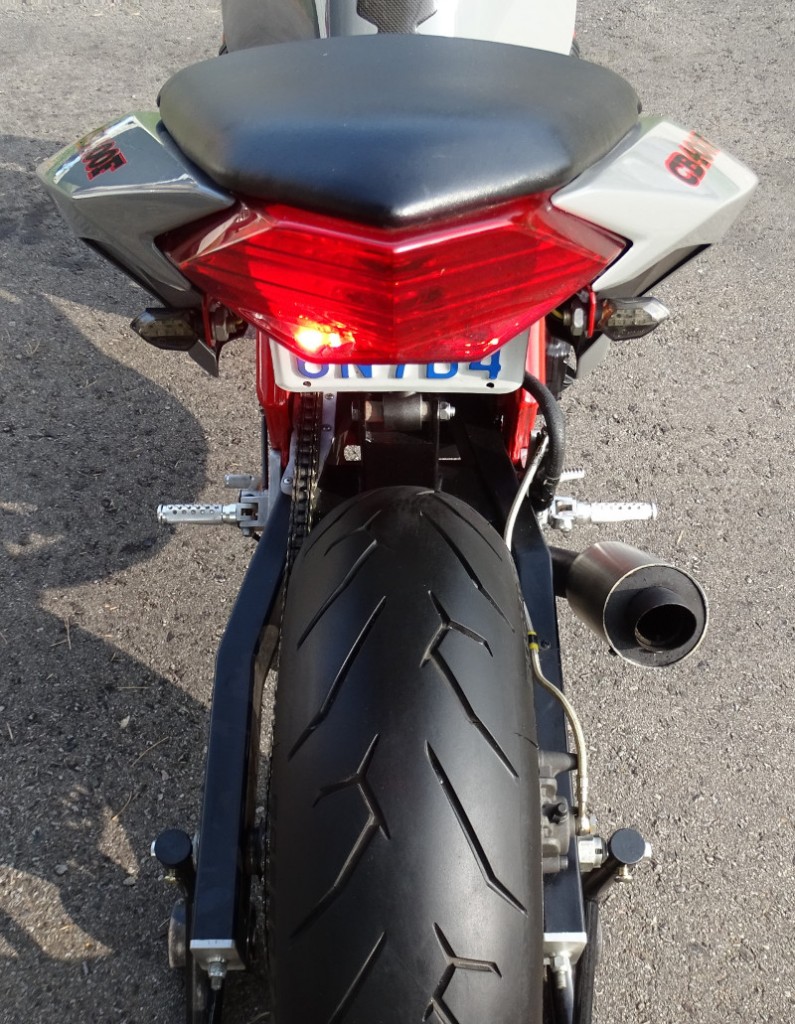

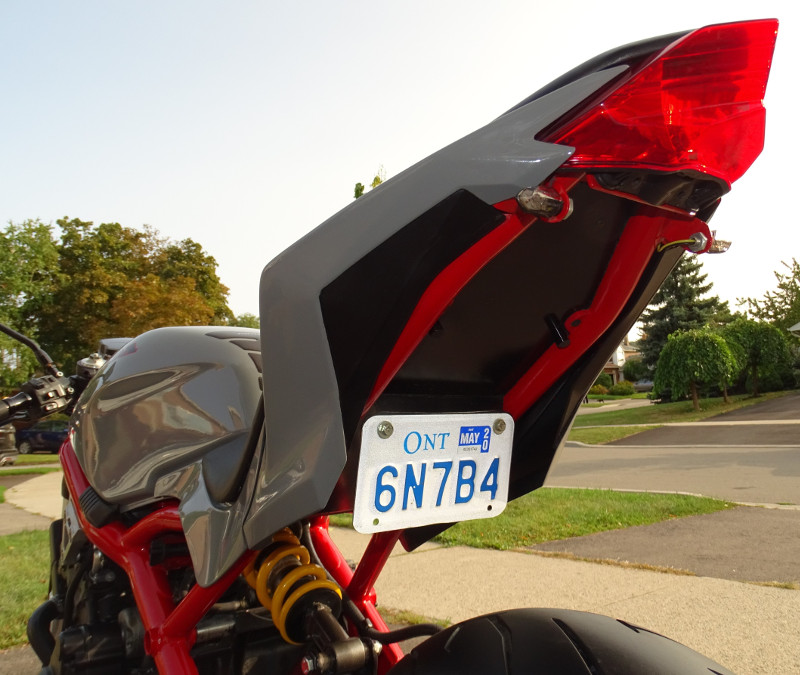
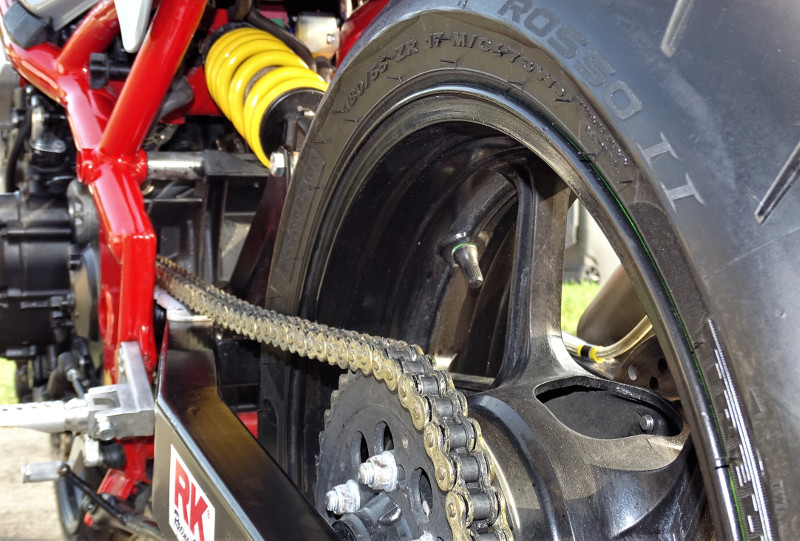

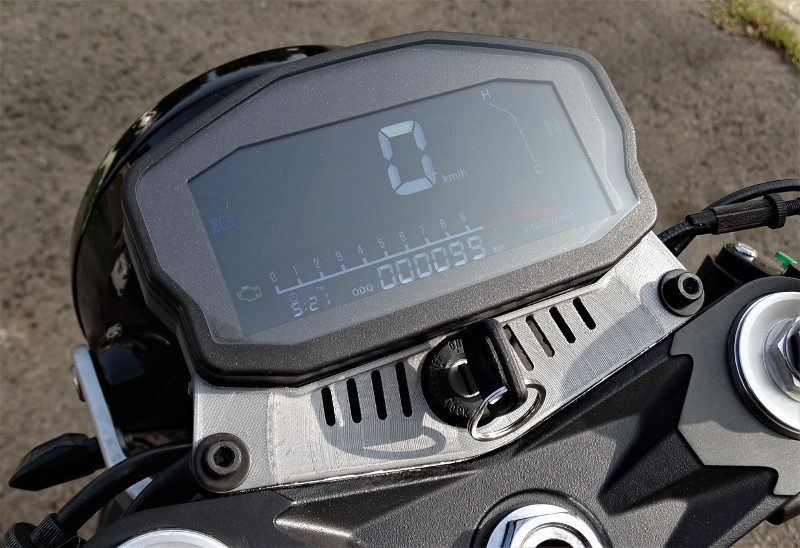






All I can see is a streetfighter with cafe racer clipons. It’s not a good look but hey, we all have different opinions!!
Looks to be an excellent quality build though.
I absolutely love this bike! Any idea what it would cost to duplicate?
Hi Joe, If you are interesting in knowing the price to duplicate, kindly send me an e-mail at [email protected]. I will be glad to discuss it with you. Thanks, Evan
I had the pleasure of meeting Bill and Evan at this year’s North American International Motorcycle Supershow. l was impressed by the enthusiasm and engineering excellence that was evident on the day. A new project is underway which I believe should be completed next year using one of the all time classic motorcycle engines. I can’t wait to see the results !